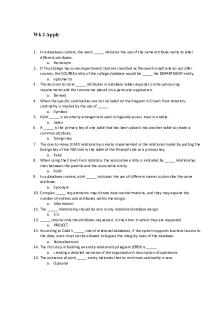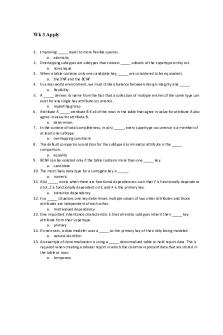Wk 2 Apply - Assingment PDF

| Title | Wk 2 Apply - Assingment |
|---|---|
| Author | Adam Lowery |
| Course | Advanced Database Architecture |
| Institution | University of Phoenix |
| Pages | 3 |
| File Size | 51.9 KB |
| File Type | |
| Total Downloads | 51 |
| Total Views | 142 |
Summary
Assingment...
Description
Wk 2 Apply
1. In a database context, the word _____ indicates the use of the same attribute name to label different attributes. a. Homonym 2. If Tiny College has some departments that are classified as "research only" and do not offer courses, the COURSE entity of the college database would be _____ the DEPARTMENT entity. a. optional to 3. The decision to store _____ attributes in database tables depends on the processing requirements and the constraints placed on a particular application. a. Derived 4. When the specific cardinalities are not included on the diagram in Crow's Foot notation, cardinality is implied by the use of _____. a. Symbols 5. A(n) _____ is an orderly arrangement used to logically access rows in a table. a. Index 6. A _____ is the primary key of one table that has been placed into another table to create a common attribute. a. foreign key 7. The one-to-many (1:M) relationship is easily implemented in the relational model by putting the foreign key of the "1" side in the table of the "many" side as a primary key. a. False 8. When using the Crow's Foot notation, the associative entity is indicated by _____ relationship lines between the parents and the associative entity. a. Solid 9. In a database context, a(n) _____ indicates the use of different names to describe the same attribute. a. Synonym 10. Complex _____ requirements may dictate data transformations, and they may expand the number of entities and attributes within the design. a. Information 11. The _____ relationship should be rare in any relational database design. a. 1:1 12. _____ returns only the attributes requested, in the order in which they are requested a. PROJECT 13. According to Codd's _____ rule of relational databases, if the system supports low-level access to the data, users must not be allowed to bypass the integrity rules of the database. a. Nonsubversion 14. The first step in building an entity-relationship diagram (ERD) is _____. a. creating a detailed narrative of the organization's description of operations 15. The existence of a(n) _____ entity indicates that its minimum cardinality is zero. a. Optional
16. The Crow's foot symbol with two vertical parallel lines indicates _____ cardinality. a. (1,1) 17. According to Codd's _____ rule of relational databases, application programs and ad hoc facilities are logically unaffected when changes are made to the table structures that preserve the original table values (changing order of columns or inserting columns). a. logical data independence 18. In organizations that generate large number of transactions, _____ are often a top priority in database design. a. high processing speeds 19. _____ relationships can be implemented by creating a new entity in 1:M relationships with the original entities. a. M:N 20. Ideally, an entity identifier is composed of _____ attribute(s). a. One 21. A _____ relationship exists when an association is maintained within a single entity. a. Unary 22. To be considered minimally relational, the DBMS must support the key relational operators _____, PROJECT, and JOIN. a. SELECT 23. The entity relationship model uses the associative entity to represent a(n) _____ relationship between two or more entities. a. M:N 24. The _____ is actually a system-created database whose tables store the user/designer-created database characteristics and contents. a. system catalog 25. A _____ relationship exists when three entities are associated. a. Ternary 26. The practical significance of taking the logical view of a database is that it serves as a reminder of the simple file concept of data storage. a. True 27. An entity is said to be _____-dependent if it can exist in the database only when it is associated with another related entity occurrence. a. Existence 28. A _____ is any key that uniquely identifies each row. a. Superkey 29. A derived attribute is indicated in the Chen notation by a _____ that connects the attribute and an entity. a. dashed line 30. Database design is a(n) _____ process based on repetition. a. Iterative 31. A(n) _____ join links tables by selecting only the rows with common values in their common attribute(s). a. Natural
32. The conceptual model can handle _____ relationships and multivalued attributes. a. M:N 33. The CUSTOMER table's primary key is CUS_CODE. The CUSTOMER primary key column has no null entries, and all entries are unique. This is an example of _____ integrity. a. Entity 34. To simplify the conceptual design, most higher-order relationships are decomposed into appropriate equivalent _____ relationships whenever possible. a. Binary 35. In the entity relationship diagram (ERD), cardinality is indicated using the _____ notation, where max is the maximum number of associated entities and min represents the minimum number of associated entities. a. (min, max) 36. Referential _____ dictates that the foreign key must contain values that match the primary key in the related table, or must contain null. a. Integrity 37. _____ expresses the minimum and maximum number of entity occurrences associated with one occurrence of the related entity. a. Cardinality 38. The _____ constraint can be placed on a column to ensure that every row in the table has a value for that column. a. NOT NULL 39. A _____ attribute is one that cannot be subdivided. a. Simple 40. In the relational model, _____ are important because they are used to ensure that each row in a table is uniquely identifiable. a. keys...
Similar Free PDFs

Wk 2 Apply - Assingment
- 3 Pages

Wk 3 Apply - Assingment
- 3 Pages

Assingment #2 QUT Parking
- 5 Pages

Tutorial 2 - Wk 2
- 6 Pages

Zeitstrahl - 1. WK bis 2. WK
- 1 Pages

WK 2 Assign
- 4 Pages

Wk 2 - Practice Questions
- 1 Pages

Defamation defences (Wk 2)
- 7 Pages

Wk 2 Tutorial Work
- 9 Pages

Wk 2 Alibaba - fins2622
- 25 Pages

Communicating Difference Wk 2
- 7 Pages

FINAL ASSINGMENT 083
- 3 Pages
Popular Institutions
- Tinajero National High School - Annex
- Politeknik Caltex Riau
- Yokohama City University
- SGT University
- University of Al-Qadisiyah
- Divine Word College of Vigan
- Techniek College Rotterdam
- Universidade de Santiago
- Universiti Teknologi MARA Cawangan Johor Kampus Pasir Gudang
- Poltekkes Kemenkes Yogyakarta
- Baguio City National High School
- Colegio san marcos
- preparatoria uno
- Centro de Bachillerato Tecnológico Industrial y de Servicios No. 107
- Dalian Maritime University
- Quang Trung Secondary School
- Colegio Tecnológico en Informática
- Corporación Regional de Educación Superior
- Grupo CEDVA
- Dar Al Uloom University
- Centro de Estudios Preuniversitarios de la Universidad Nacional de Ingeniería
- 上智大学
- Aakash International School, Nuna Majara
- San Felipe Neri Catholic School
- Kang Chiao International School - New Taipei City
- Misamis Occidental National High School
- Institución Educativa Escuela Normal Juan Ladrilleros
- Kolehiyo ng Pantukan
- Batanes State College
- Instituto Continental
- Sekolah Menengah Kejuruan Kesehatan Kaltara (Tarakan)
- Colegio de La Inmaculada Concepcion - Cebu



